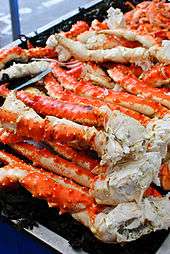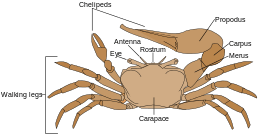Declawing of crabs

Declawing of crabs is the process whereby one or both claws of a live crab (including king crabs) are manually pulled off and the animal is then returned to the water. It occurs in several fisheries worldwide, such as in the Florida stone crab (Menippe mercenaria) fishery, the north-east Atlantic deep-water red crab (Chaceon affinis) fishery and in southern Iberia, where the major claws of the fiddler crab Uca tangeri are harvested. Around Northern Europe, an extensive fishery exists for claws of the edible crab, Cancer pagurus. The practice is defended because some crabs can naturally autotomise (shed) limbs and then about a year later after a series of moults, regenerate these limbs.[1] It is argued that declawing therefore provides a sustainable fishery. Claw removal is also promoted to assist in handling of animals, and to decrease losses through entanglement in nets and cannibalism.[2][3] Declawing crabs is legal in the UK since revocation in 2000 of the Crab Claws (Prohibition of Landing) Order 1986. One crab that is subject to widespread declawing is the Florida stone crab, for which tourist information is provided.[4]
Procedure

To perform declawing, the claws are snapped downward away from the crab. To ensure a clean break along the natural fracture plane, one finger is placed on the basal cheliped joint. With the cheliped fully extended, a quick, firm downward motion normally removes the claw cleanly. The break usually occurs at the basi-ischum between the coxa at the base of the leg and the merus.
Production
In the 1976–77 trapping season, about 50,000 kg of claws were harvested in the Everglades National Park.[5] This was probably less than 5% of the total Floridian harvest, which has averaged more than 1,000,000 kilograms since 1974.[6]
In Florida during the 1995–96 to 2004–05 fishing seasons, fishers declawed approximately 10.5 million crabs during each 7-month fishing season. The weight of crab claws landings varied without trend since 1989–90. Peak landings were 1.6 million kg statewide in the 1997–98 fishing season. Statewide landings for 2004–05 were 1.4 million kg of claws.[7]
Effects on mortality
Under experimental conditions, but using commercially accepted techniques, 47% of stone crabs that had both claws removed died after declawing, and 28% of single claw amputees died; 76% of the casualties died within 24 hours of declawing. The claws constituted 51% of the total weight of the crabs before declawing.[8] In the wild, where declawed crabs must compete for food, mates, and shelter, and avoid predators, the mortality rate is likely to be higher. Declawed crabs survive by switching from predation to scavenging.[9] The occurrence of regenerated claws in the fishery harvest is low, with studies calculating from less than 10% (1978),[8] 13% (2006),[7] to 20% (2010).[10] Larger, older crabs generally do not survive long enough to regrow their claws, as they are near the end of their lifespan.
Effects on feeding
Most crabs use their claws for capturing and eating prey. A crab with one claw removed would therefore be disadvantaged in subsequent feeding and a crab with both claws removed even more so. In a study on the effects of declawing on feeding, autotomy induced (declawed) crabs consumed significantly fewer mussels and less mussel mass, but ate more mass of fish (a more readily handled food source). This indicates that the effect of autotomy was a reduction of the ability to feed on mussels, rather than a general reduction of feeding motivation.[2] In a second study, there was no discernible difference in the amount of food consumed by crabs surviving declawing and control crabs.[8] It has been argued that should a crab survive declawing it will not be able to feed effectively and may subsequently die of starvation.[3]
Effects on activity
Declawed crabs show significantly lower activity levels than negative controls.[8]
Pain and stress caused by declawing
There is debate about whether invertebrates can experience pain. Some of the most compelling evidence for pain in invertebrates exists for crustaceans in terms of trade-offs between stimulus avoidance and other motivational requirements. Evidence of the ability for crabs to feel pain is supported by their possessing an opioid receptor system, showing learned avoidance to putatively painful stimuli, and responding appropriately to analagesics and anaesthetics. These all indicate it is likely that crabs can experience pain during declawing.
It has been argued that because crabs can autotomise (self-amputate) their claws, manual declawing along these natural fracture planes will not cause pain. However, a lack or reduction of pain during autotomy remains to be verified. Moreover, declawing results in a physiological stress response in the edible crab, as indicated by increases in haemolymph glucose and lactate and a decrease in glycogen. This stress is evident both in the short term (< 10 min) and the long term (24 h). Further, declawing is more stressful, results in bigger wounds and causes significant mortality compared to induced autotomy.[11]
See also
References
- ↑ "Stone crabs FAQs". Florida Fish and Wildlife Conservation Commission. Retrieved 23 September 2012.
- 1 2 Lynsey Patterson; Jaimie T. A. Dick; Robert W. Elwood (2009). "Claw removal and feeding ability in the edible crab, Cancer pagurus: implications for fishery practice". Applied Animal Behaviour Science. 116 (2): 302–305. doi:10.1016/j.applanim.2008.08.007.
- 1 2 Queen's University, Belfast (10 October 2007). "Declawing crabs may lead to their death". Science Daily. Retrieved 21 September 2012.
- ↑ "Recreational stone crabbing information". Florida Fish and Wildlife Conservation Commission. Retrieved November 4, 2012.
- ↑ G. E. Davis; E. B. Thue (1977). Annual fishery management report for Everglades National Park, Florida, No. 1. Homestead, Florida: Everglades National Park, U. S. National Park Service.
- ↑ Florida Department of Natural Resources (1977). Florida landings, annual summary, 1975. Current Fisheries Statistics. 6919. Washington, DC: NOAA/National Marine Fisheries Service.
- 1 2 "The 2006 Stock Assessment Update for the Stone Crab, Menippe spp., Fishery in Florida". Florida Fish and Wildlife Conservation Commission. Retrieved 23 September 2012.
- 1 2 3 4 Gary E. Davis; Douglas S. Baughman; James D. Chapman; Donald MacArthur; Alan C. Pierce (1978). Mortality associated with declawing stone crabs, Menippe mercenaria (PDF). US National Park Service. Report T-522.
- ↑ Stone Crab FAQ: If a stone crab looses [sic] both claws how can it eat and defend itself?
- ↑ Species Account - Invertebrates: Florida Stone Crab (Menippe mercenaria) and Gulf Stone Crab (M. adina)
- ↑ Lynsey Patterson; Jaimie T. A. Dick; Robert W. Elwood (2007). "Physiological stress responses in the edible crab, Cancer pagurus, to the fishery practice of de-clawing". Marine Biology. 152 (2): 265–272. doi:10.1007/s00227-007-0681-5.